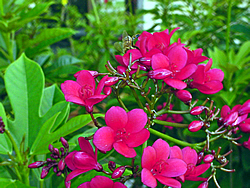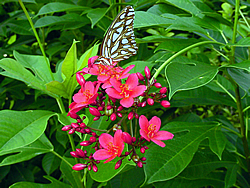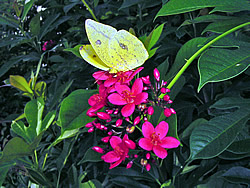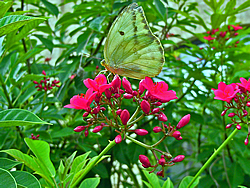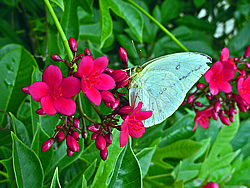Search
For The Answer
Click here to access our database of
Plant Answers
Search
For The Picture
Click here to access the Google database of plants
and insects
Information
Index
Alphabetical Listing of Topics, Recommendations
and Plants
Milberger's Nursery and Landscaping
3920 North Loop 1604 E.
San Antonio, TX 78247
210.497.3760
nursery@milbergersa.com
Open 9 to 6 Mon. through Sat.
and 10 to 5 on Sun.

Three exits east of 281, inside of 1604
Next to the Diamond Shamrock station
Please click map for more detailed map and driving directions.
| Jumping Jatropha, A Spicy Plant Say hello to a great plant, Jatropha integerrima, as one of next year*s Texas Superstars*. This subtropical plant is known under a variety of common names including spicy jatropha, chaya, firecracker, firecracker jatroph, or peregrina. As these names imply this plant adds a spicy zest to summer landscapes with handsome dark glossy green foliage that serves as the perfect foil for the rounded clusters of waxy red to pink flowers. These flowers are borne above the foliage in full view. Most spicy jatropha grown for our region have cherry or lip-stick red flowers that bloom from spring to frost, but pink flowering selections may also be found. If the flowers were not so attractive, one might be tempted to grow spicy jatropha anyway as the moderately coarse textured leaves are a rich dark green and come in a variety of interesting lobed patterns. Spicy jatropha has long been popular in tropical climates where
it is grown as a shrub or small tree, reaching 10 ft or more in
height and width. There it is popular as a screen or general purpose
evergreen hedge. In southern parts of Texas, Spicy Jatropha will
return regularly as a perennial or dieback shrub. In the rest
of the region, Spicy Jatropha makes a great summer annual or patio
container plant. Performance is best during hot muggy weather,
just what the plant doctor ordered for our Texas* summers. In
fact the genus name, Jatropha is derived from the Greek words
for physician and food, in reference to the One of the best uses for spicy jatropha is as a patio or sidewalk container plant where the flowers can be enjoyed at close range. Of course patios and sidewalks can be tough places environmentally for flowering plants, so the ability of spicy jatropha to withstand reflected heat and periodic drought come to the forefront. Spicy jatropha also exhibits a good level of salt tolerance and ability to withstand a wide range of soil pH as long as the soils are well drained. Few insects or diseases bother spicy jatropha in the landscape. Fortunately, spicy jatropha will retain a reasonably dense foliar canopy and also continue to flower, but at a somewhat reduced rate, under shady conditions making it a good choice for a variety of light exposures. Excellent dark green foliage, great red to pink flowers, tolerance of sun to shade, heat, drought, and a lack of fussiness about soils combine to make spicy jatropha a great way to spice up next summer*s sales.
|
||||||




